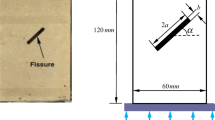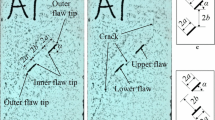Abstract
Discontinuities are inherent components of rock masses and can range from fissures to large faults. Single fissures, the so-called flaws, may affect the mechanical behavior of rock mass, crack initiation, and propagation. In this paper, numerical investigations have been conducted on central-flawed cylindrical specimens subjected to axial loading to investigate the effect of flaw angle (α), length (2a), and aperture (A) on their mechanical behavior and crack development. Particle Flow Code (PFC3D) was adopted to investigate the cracking process of the cylindrical specimens and maximum principal stresses at flaw tips. The numerical models are calibrated and verified using extensive experimental tests. The results show that increasing α, UCS, and E increase while increasing 2a decreases UCS and E, and A does not affect these two parameters. Moreover, numerical simulations reveal that as α rises, the three principal stresses generally fall when 2a = 13 and 26 mm. σ1 and σ3 peak at α = 45°, and σ2 reaches a maximum at α = 30° in models with 2a = 39 mm. The cracking patterns resulting from both methods are highly consistent in that tensile cracks type 1 mainly form at α = 15° to 75°, and tensile cracks type 3 are dominant at other angles. Finally, it is concluded that flaw aperture scarcely affects failure patterns.
























Similar content being viewed by others
Abbreviations
- UCS :
-
Unconfined compressive strength (MPa)
- E :
-
Modulus of elasticity (GPa)
- σ t :
-
Tensile strength (MPa)
- ν :
-
Poisson’s ratio
- E c :
-
Particle modulus of elasticity (GPa)
- \(\overline{\lambda }\) :
-
Radius multiplier
- α :
-
Flaw inclination angle (°)
- A :
-
Flaw aperture (mm)
- 2a :
-
Flaw length (mm)
- \(\overline{{E }_{c}}\) :
-
Elastic modulus of flat-joint bonds (GPa)
- k n :
-
Normal stiffness of ball contact (N/m)
- k s :
-
Shear stiffness of ball contacts (N/m)
- R max :
-
Maximum radius of balls (mm)
- R min :
-
Minimum radius of balls (mm)
- \(\overline{{k }_{s}}\) :
-
Shear stiffness of flat-joint bonds (N/m)
- \(\overline{{k }_{n}}\) :
-
Normal stiffness of flat-joint bonds (N/m)
- σ xx, σ yy, σ zz , σ xy, σ xz, σ yz :
-
Stress tensor components in global coordinate x, y, z (MPa)
- σ 1, σ 2, σ 3 :
-
Principal stresses (MPa)
- n 1, n2, n 3 :
-
Principal stress direction vectors
- i, j, k :
-
Unit vectors in global coordinate x, y, z
References
Asadizadeh M, Hossaini MF, Moosavi M et al (2019) Mechanical characterisation of jointed rock-like material with non-persistent rough joints subjected to uniaxial compression. Eng Geol 260:105224. https://doi.org/10.1016/j.enggeo.2019.105224
Asadizadeh M, Karimi J, Hossaini MF et al (2022) The effect of central flaw on the unconfined strength of rock-like specimens: an intelligent approach. Iran J Sci Technol Transact Civil Eng. https://doi.org/10.1007/s40996-022-00825-w
Asadizadeh M, Moosavi M, Hossaini MF, Masoumi H (2018) Shear strength and cracking process of non-persistent jointed rocks: an extensive experimental investigation. Rock Mech Rock Eng 51:415–428. https://doi.org/10.1007/s00603-017-1328-6
Bahaaddini M, Sharrock G, Hebblewhite BK (2013a) Numerical direct shear tests to model the shear behaviour of rock joints. Comput Geotech 51:101–115. https://doi.org/10.1016/j.compgeo.2013.02.003
Bahaaddini M, Sharrock G, Hebblewhite BK (2013b) Numerical investigation of the effect of joint geometrical parameters on the mechanical properties of a non-persistent jointed rock mass under uniaxial compression. Comput Geotech 49:206–225. https://doi.org/10.1016/j.compgeo.2012.10.012
Bieniawski ZT (1967) Mechanism of brittle fracture of rock: Part I—theory of the fracture process. Int J Rock Mech Mining Sci Geomech Abstr 4:395–406. https://doi.org/10.1016/0148-9062(67)90030-7
Bieniawski ZT (1967) Mechanism of brittle fracture of rock: Part II—experimental studies. Int J Rock Mech Mining Sci Geomech Abstr 4:407–423. https://doi.org/10.1016/0148-9062(67)90031-9
Bobet A (2000) The initiation of secondary cracks in compression. Eng Fract Mech 66:187–219. https://doi.org/10.1016/S0013-7944(00)00009-6
Bobet A, Einstein HH (1998a) Fracture coalescence in rock-type materials under uniaxial and biaxial compression. Int J Rock Mech Min Sci 35:863–888. https://doi.org/10.1016/S0148-9062(98)00005-9
Bobet A, Einstein HH (1998b) Numerical modeling of fracture coalescence in a model rock material. Int J Fract 1998b 92(3)221–252. https://doi.org/10.1023/A:1007460316400
Fan W, Yang H, Jiang X, Cao P (2021) Experimental and numerical investigation on crack mechanism of folded flawed rock-like material under uniaxial compression. Eng Geol 291:106210. https://doi.org/10.1016/j.enggeo.2021.106210
Hoek E, Martin CD (2014) Fracture initiation and propagation in intact rock – a review. J Rock Mech Geotechl Eng 6:287–300. https://doi.org/10.1016/j.jrmge.2014.06.001
Horii H, Nemat-Nasser S (1985) Compression-induced microcrack growth in brittle solids: axial splitting and shear failure. J Geophys Res: Solid Earth 90:3105–3125. https://doi.org/10.1029/JB090IB04P03105
Huang Y-H, Yang S-Q, Tian W-L, Wu S-Y (2022) Experimental and DEM study on failure behavior and stress distribution of flawed sandstone specimens under uniaxial compression. Theoret Appl Fract Mech 118:103266. https://doi.org/10.1016/j.tafmec.2022.103266
Itasca Consulting Group Inc. (2022) PFC3D manual
Jin J, Cao P, Chen Y et al (2017) Influence of single flaw on the failure process and energy mechanics of rock-like material. Comput Geotech 86:150–162. https://doi.org/10.1016/j.compgeo.2017.01.011
Karimi J, Asadizadeh M, Hossaini MF et al (2021) Compressive strength of flawed cylindrical specimens subjected to axial loading. Geomech Eng 1:87–99. https://doi.org/10.12989/gae2021.27.1.087
Li Y-P, Chen L-Z, Wang Y-H (2005) Experimental research on pre-cracked marble under compression. Int J Solids Struct 42:2505–2516
Lin H, Yang H, Wang Y et al (2019) Determination of the stress field and crack initiation angle of an open flaw tip under uniaxial compression. Theoret Appl Fract Mech 104:102358. https://doi.org/10.1016/j.tafmec.2019.102358
Liu Q, Xu J, Liu X et al (2015) The role of flaws on crack growth in rock-like material assessed by AE technique. Int J Fract 193:99–115
Manouchehrian A, Sharifzadeh M, Marji MF, Gholamnejad J (2014) A bonded particle model for analysis of the flaw orientation effect on crack propagation mechanism in brittle materials under compression. Arch Civil Mech Eng 14:40–52. https://doi.org/10.1016/j.acme.2013.05.008
Martin CD, Chandler NA (1994) The progressive fracture of Lac du Bonnet granite. Int J Rock Mech Mining Sci Geomech Abstr 31:643–659. https://doi.org/10.1016/0148-9062(94)90005-1
Mase GT, Smelser RE, Rossmann JS (1999) Continuum Mechanics for Engineers. CRC Press, New York, Second Edi
Nemat-Nasser S, Horii H (1982) Compression-induced nonplanar crack extension with application to splitting, exfoliation, and rockburst. J Geophys Res 87:6805. https://doi.org/10.1029/JB087iB08p06805
Niu Y, Zhou X-P, Berto F (2020) Evaluation of fracture mode classification in flawed red sandstone under uniaxial compression. Theoret Appl Fract Mech 107:102528. https://doi.org/10.1016/j.tafmec.2020.102528
Potyondy DO (2012) A flat-jointed bonded-particle material for hard rock. 46th US Rock Mechanics/Geomechanics Symposium 10
Shen J, Zhan S, Karakus M, Zuo J (2021) Effects of flaw width on cracking behavior of single-flawed rock specimens. Bull Eng Geol Env 80:1701–1711. https://doi.org/10.1007/s10064-020-02029-w
Sun W, Wu S, Zhou Y, Zhou J (2019) Comparison of crack processes in single-flawed rock-like material using two bonded–particle models under compression. Arab J Geosci 12:156. https://doi.org/10.1007/s12517-019-4327-y
Tang CA, Lin P, Wong RHC, Chau KT (2001a) Analysis of crack coalescence in rock-like materials containing three flaws—Part II: numerical approach. Int J Rock Mech Min Sci 38:925–939. https://doi.org/10.1016/S1365-1609(01)00065-X
Tang CAA, Lin P, Wong RHCHC, Chau KTT (2001b) Analysis of crack coalescence in rock-like materials containing three flaws—Part I: experimental approach. Int J Rock Mech Min Sci 38:925–939. https://doi.org/10.1016/S1365-1609(01)00065-X
Vaziri MR, Tavakoli H, Bahaaddini M (2022) Statistical analysis on the mechanical behaviour of non-persistent jointed rock masses using combined DEM and DFN. Bull Eng Geol Env 81:177. https://doi.org/10.1007/s10064-022-02674-3
Wang Y, Zhang H, Lin H et al (2020) Fracture behaviour of central-flawed rock plate under uniaxial compression. Theoret Appl Fract Mech 106:102503. https://doi.org/10.1016/j.tafmec.2020.102503
Wittke W (2014) Rock mechanics based on an anisotropic jointed rock model. Wilhelm Ernst & Sohn, Berlin
Wong L, Einstein H (2006) Fracturing behavior of prismatic specimens containing single flaws. Proceedings of the 41st US Rock Mechanics Symposium - ARMA’s Golden Rocks 2006 - 50 Years of Rock Mechanics
Wong LNY, Einstein HH (2009) Systematic evaluation of cracking behavior in specimens containing single flaws under uniaxial compression. Int J Rock Mech Min Sci 46:239–249
Yang S-Q, Tian W-L, Huang Y-H et al (2018) Experimental and discrete element modeling on cracking behavior of sandstone containing a single oval flaw under uniaxial compression. Eng Fract Mech 194:154–174. https://doi.org/10.1016/j.engfracmech.2018.03.003
Yin P, Wong RHC, Chau KT (2014) Coalescence of two parallel pre-existing surface cracks in granite. International Journal of Rock Mechanics and Mining Sciences 68:66–84. https://doi.org/10.1016/j.ijrmms.2014.02.011
Zhang XP, Wong LNY (2012) Cracking processes in rock-like material containing a single flaw under uniaxial compression: a numerical study based on parallel bonded-particle model approach. Rock Mech Rock Eng 45:711–737. https://doi.org/10.1007/s00603-011-0176-z
Zhao C, Niu J, Zhang Q et al (2019) Failure characteristics of rock-like materials with single flaws under uniaxial compression. Bull Eng Geol Env 78:593–603. https://doi.org/10.1007/s10064-018-1379-2
Zhou XP, Cheng H, Feng YF (2014) An experimental study of crack coalescence behaviour in rock-like materials containing multiple flaws under uniaxial compression. Rock Mech Rock Eng 47:1961–1986. https://doi.org/10.1007/s00603-013-0511-7
Author information
Authors and Affiliations
Corresponding author
Ethics declarations
Competing interests
The authors declare no competing interests.
Rights and permissions
Springer Nature or its licensor holds exclusive rights to this article under a publishing agreement with the author(s) or other rightsholder(s); author self-archiving of the accepted manuscript version of this article is solely governed by the terms of such publishing agreement and applicable law.
About this article
Cite this article
Asadizadeh, M., Khosravi, S., Karimi, J. et al. Mechanical behavior of single-flawed cylindrical specimens subjected to axial loading: a numerical investigation. Bull Eng Geol Environ 81, 442 (2022). https://doi.org/10.1007/s10064-022-02940-4
Received:
Accepted:
Published:
DOI: https://doi.org/10.1007/s10064-022-02940-4




